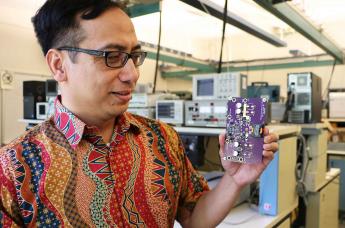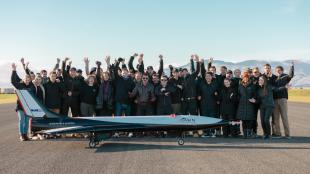Professor’s Device Could Provide Light to Millions Living in the Dark

A Cal Poly electrical engineering professor said his soon-to-be patented device could provide light to the more than 1.6 billion people living far off the grid.
The “Multiple Input Single Output DC-DC Converter with Equal Load Sharing on Multiple Inputs” — or MISO — makes it possible to combine the input of multiple low-power electricity sources into one stronger output source. It was developed by the professor, Taufik, and former student Owen Jong, who earned an electrical engineering bachelor’s degree in 2012.
Taufik has one name, which is common in his native Indonesia, where much of the population lives on remote islands with limited electricity.
“MISO allows any type of low-power energy device — solar, wind, water in a stream, even human-powered generators like a bicycle — to be connected to one house,” Taufik said. “It’s collecting multiple little sources of energy into one bigger source. In the developing world, a little electricity goes a long way. Just keeping a light on at night is huge.”
The U.S. Patent and Trademark Office recently notified Taufik that the patent would be awarded this fall for MISO.
The device looks like a circuit board and is small enough to hold in one hand — yet its impact could be profound, the professor said. MISO’s ability to work with direct current (DC) electricity is the key to making it more efficient. Power converters will be needed, because the grid uses alternating current (AC) while renewable power sources, such as solar panels and small-scale wind turbines, produce DC power.
“Converters add to the expense and are less efficient by 15 to 35 percent depending on the load,” said Taufik, who runs the DC House project on campus, which seeks to create a house in which electricity is provided by direct current, rather than the traditionally used AC power. “It makes no sense for people in rural areas that live off the grid to convert DC to AC. It’s much more efficient to stay with DC power.”
Taufik, who previously received a patent for a “Multiphase DC-DC Converter for Voltage Regulator Module” to supply power to microprocessors, worked with Cal Poly’s Office of Research and Economic Development to secure the MISO patent.
“The research to get MISO started actually began in 2010, because it’s a critical component in the DC House project, and the patent process took almost three years,” he said. “Different ideas for MISO converters were attempted and improvements were continuously sought after until we believe we found the best — and unique — solution.”
The device would come in different sizes, each small enough to hold in one hand. Prototypes for the device cost between $50 and $80, though Taufik notes that prototypes are usually more expensive than mass-produced products.
Taufik shared the credit for the invention.
“The work toward this patent would never have been accomplished without the help of many of my former students who took on the challenges in the MISO converter project, and in the overall DC House project,” he said. “I truly owe this patent to these hard working and bright students.”
Having been born and raised in Indonesia, where he frequently returns, Taufik sees a worldwide market for MISO.
“Hopefully, we can market this to companies that deal with electrification in developing countries or even rural areas of the U.S. where people want to live off the grid,” said Taufik, who has taught at Cal Poly since 1999. “There’s an off-the-grid community east of Santa Maria, Quail Springs, that contacted us because they want to build a DC-powered house. We’ve had a lot of interest in it because, right now, the world is beginning to learn that residential DC power is more efficient — and cheaper.”


